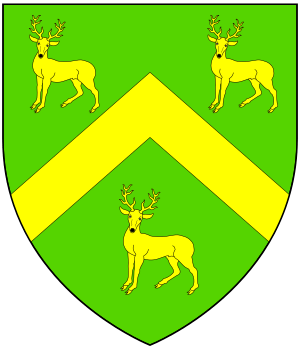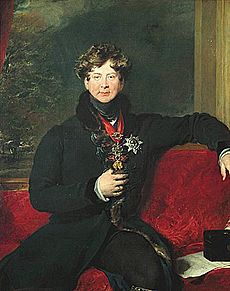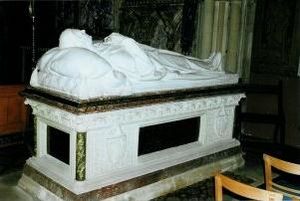F. J. Robinson, 1st Viscount Goderich facts for kids
Quick facts for kids
The Earl of Ripon
|
|||||||||||||||||||||||||||||||||||||||||||||||||||||||||||||||||||||||||||||||||||||||||||||||||||||
|---|---|---|---|---|---|---|---|---|---|---|---|---|---|---|---|---|---|---|---|---|---|---|---|---|---|---|---|---|---|---|---|---|---|---|---|---|---|---|---|---|---|---|---|---|---|---|---|---|---|---|---|---|---|---|---|---|---|---|---|---|---|---|---|---|---|---|---|---|---|---|---|---|---|---|---|---|---|---|---|---|---|---|---|---|---|---|---|---|---|---|---|---|---|---|---|---|---|---|---|---|---|
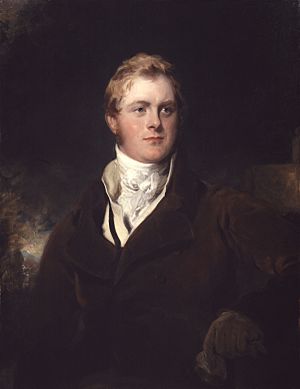
Portrait by Thomas Lawrence, c. 1824
|
|||||||||||||||||||||||||||||||||||||||||||||||||||||||||||||||||||||||||||||||||||||||||||||||||||||
| Prime Minister of the United Kingdom | |||||||||||||||||||||||||||||||||||||||||||||||||||||||||||||||||||||||||||||||||||||||||||||||||||||
| In office 31 August 1827 – 21 January 1828 |
|||||||||||||||||||||||||||||||||||||||||||||||||||||||||||||||||||||||||||||||||||||||||||||||||||||
| Monarch | George IV | ||||||||||||||||||||||||||||||||||||||||||||||||||||||||||||||||||||||||||||||||||||||||||||||||||||
| Preceded by | George Canning | ||||||||||||||||||||||||||||||||||||||||||||||||||||||||||||||||||||||||||||||||||||||||||||||||||||
| Succeeded by | The Duke of Wellington | ||||||||||||||||||||||||||||||||||||||||||||||||||||||||||||||||||||||||||||||||||||||||||||||||||||
|
|||||||||||||||||||||||||||||||||||||||||||||||||||||||||||||||||||||||||||||||||||||||||||||||||||||
| Personal details | |||||||||||||||||||||||||||||||||||||||||||||||||||||||||||||||||||||||||||||||||||||||||||||||||||||
| Born |
Frederick John Robinson
1 November 1782 Skelton-on-Ure, Yorkshire, England |
||||||||||||||||||||||||||||||||||||||||||||||||||||||||||||||||||||||||||||||||||||||||||||||||||||
| Died | 28 January 1859 (aged 76) Putney Heath, Surrey, England |
||||||||||||||||||||||||||||||||||||||||||||||||||||||||||||||||||||||||||||||||||||||||||||||||||||
| Resting place | All Saints' Church, Nocton | ||||||||||||||||||||||||||||||||||||||||||||||||||||||||||||||||||||||||||||||||||||||||||||||||||||
| Political party |
|
||||||||||||||||||||||||||||||||||||||||||||||||||||||||||||||||||||||||||||||||||||||||||||||||||||
| Spouse | |||||||||||||||||||||||||||||||||||||||||||||||||||||||||||||||||||||||||||||||||||||||||||||||||||||
| Parent |
|
||||||||||||||||||||||||||||||||||||||||||||||||||||||||||||||||||||||||||||||||||||||||||||||||||||
| Alma mater | St John's College, Cambridge | ||||||||||||||||||||||||||||||||||||||||||||||||||||||||||||||||||||||||||||||||||||||||||||||||||||
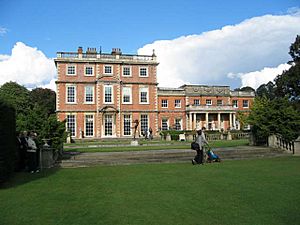
Frederick John Robinson, 1st Earl of Ripon (born November 1, 1782 – died January 28, 1859), was a British politician. He is best known as The Viscount Goderich, a title he held from 1827 to 1833. He served as Prime Minister of the United Kingdom for a short time, from 1827 to 1828.
Robinson came from a wealthy landowning family. He started his political career in the House of Commons. He slowly moved up the ranks, becoming a cabinet minister in 1818. In 1823, he became the Chancellor of the Exchequer, which means he was in charge of the country's money.
In 1827, he was given the title of Viscount Goderich and moved to the House of Lords. He became the leader of the House of Lords and the Secretary of State for War and the Colonies.
Later in 1827, the Prime Minister, George Canning, sadly passed away. Goderich took over as Prime Minister. However, he found it hard to keep the different political groups working together. He resigned after only 144 days. Both Canning and Goderich had very short times as Prime Minister.
After being Prime Minister, Goderich continued to serve in the government. He worked with two later Prime Ministers, Earl Grey and Sir Robert Peel.
Contents
Frederick John Robinson's Early Life
Growing Up in Yorkshire
Frederick John Robinson was born at Newby Hall in Yorkshire, England. He was the second son of Thomas Robinson, 2nd Baron Grantham. His mother was Lady Mary Yorke.
He went to Harrow School from 1796 to 1799. Then, he studied at St John's College, Cambridge, from 1799 to 1802. He was very good at studying ancient Greek and Roman subjects. He even won a medal for his Latin writing in 1801. After college, he studied law but decided not to become a lawyer.
During the Napoleonic Wars, he also served part-time in the military. He was a captain and later a major in the local cavalry.
Starting His Political Career
Robinson began his political journey thanks to his family. His mother's cousin, the third Earl of Hardwicke, was the Lord Lieutenant of Ireland. He hired Robinson as his private secretary in 1804.
Two years later, he helped Robinson get a seat in Parliament for Carlow. This was a "pocket borough," meaning a powerful person could easily choose who would represent it. In 1807, Robinson changed seats and became the MP for Ripon, which was near his family home.
Early in his career, he turned down some junior government jobs. This was out of respect for his family connection, who didn't agree with the Prime Minister at the time. However, George Canning, who was in charge of foreign affairs, chose him for a special mission to Austria. Even though the mission wasn't successful, Robinson's reputation stayed good. He was given several small jobs in different governments.
His political ideas were greatly influenced by Canning. But he also became a close helper to Canning's rival, Lord Castlereagh. Castlereagh made him an under-secretary in the War Office in 1809. When Castlereagh resigned, Robinson resigned too. Later, in 1810, he joined the Admiralty board, which managed the navy.
In 1812, he became a Privy Counsellor. This is a group of important advisors to the King.
Family Life
In 1814, Robinson married Lady Sarah Albinia Louisa Hobart. They had three children, but only one lived to be an adult:
- George Frederick Samuel Robinson (born 1827), who later became the 1st Marquess of Ripon.
Robinson worked as the Vice-President of the Board of Trade from 1812 to 1818. He was also a joint-Paymaster of the Forces from 1813 to 1817. In this role, he supported the Corn Laws of 1815. These laws were meant to protect British farmers by keeping the price of imported wheat high.
The Corn Laws made food expensive for ordinary people. While the law was being discussed, angry people attacked Robinson's house in London. They broke his door and threw furniture out the window. During one attack, two people were shot. Robinson was very upset when he talked about this in Parliament, which earned him the nickname "the Blubberer."
Becoming a Cabinet Minister

In 1818, Robinson joined the most important group of government ministers, the cabinet. He became the President of the Board of Trade and Treasurer of the Navy. This was under the leadership of Prime Minister Lord Liverpool. In 1823, he took over as Chancellor of the Exchequer.
Robinson was seen as a very successful Chancellor. The country's money was in good shape, and the government had extra money for three years. He lowered taxes and helped fund the Royal Library and the National Gallery. Because of his success and his support for important social changes, he earned two more nicknames: "Prosperity Robinson" and "Goody."
His last year as Chancellor had some financial difficulties. But he was not blamed for these problems.
Under pressure, Robinson asked for a different job. In January 1827, he was given the title of Viscount Goderich. However, the Prime Minister, Lord Liverpool, became ill and resigned. George Canning became the new Prime Minister.
Canning's appointment caused a big split among politicians. Goderich supported Canning and became the Leader of the House of Lords and Secretary of State for War and the Colonies. In the House of Lords, he faced a lot of criticism from those who opposed Canning. When he tried to pass a new Corn Law, it was defeated.
His Time as Prime Minister
Prime Minister Canning's health was not good, and he died on August 8, 1827. Many people thought the King would choose the Duke of Wellington to be the next Prime Minister. But the King was still upset that Wellington had refused to work with Canning.
Instead, the King chose Goderich to be the new Prime Minister.
Goderich immediately faced challenges. He struggled to balance the King's wishes with the demands of his political allies. The King didn't want too many members of the Whig party in the cabinet, but the Whigs wanted more power. Goderich couldn't make everyone happy.
One important politician said that Goderich was "unfit for the situation he occupies" because he seemed so weak. The King himself was not impressed, calling Goderich "a damned, snivelling, blubbering blockhead."
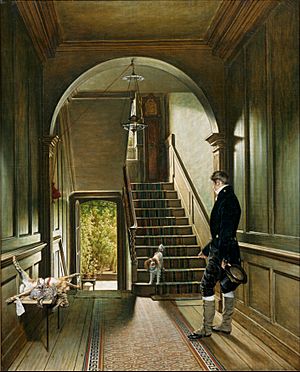
By January 1828, the King decided that Goderich's government couldn't continue. He wanted a government led by the Duke of Wellington. Goderich had already written a letter to resign. He described how his government was falling apart. The King then asked Wellington to form a new government.
Goderich was said to be in tears during his meeting with the King. But within days, he was happy to be free from the job. He said he was "quite another man" and could "sleeps at nights now." His time as Prime Minister lasted only 144 days. This makes it one of the shortest in British history.
A painting by Dutch artist Pieter Christoffel Wonder shows Goderich on the day he resigned. It is called "The Staircase of the London Residence of the Painter."
Later Cabinet Posts
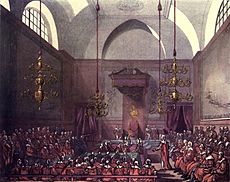
In 1830, Goderich joined the Whig party. He became the Colonial Secretary in Lord Grey's government. He was strongly against slavery throughout his career. In the 1830s, he worked hard to free slaves across the British Empire. His work was continued by his successor, Lord Stanley. Goderich helped pass the law to abolish slavery through the House of Lords.
In 1833, Goderich was given an even higher title: Earl of Ripon. He didn't ask for this, but he wanted to accept a special award from the King, the Order of the Garter. At that time, a viscount was not considered high enough rank for it.
He left the Colonial Office that same year. He didn't want any more government jobs, but Lord Grey insisted he take the important role of Lord Privy Seal. However, the next year, Goderich and Stanley left the Whig party. They disagreed with plans that they felt threatened the Church of Ireland.
From 1841 to 1843, Ripon served in Robert Peel's government as President of the Board of Trade. W. E. Gladstone, who would later become a famous Prime Minister, was his deputy. His last government job was President of the Board of Control from 1843 to 1846.
During his long career, he was part of almost every government between 1818 and 1846. He changed his political group several times, showing he was willing to work with different parties.
Besides politics, Goderich was also involved in other important groups. He was president of the Royal Geographical Society from 1830 to 1833. He also led the Royal Society of Literature from 1834 to 1845.
Frederick John Robinson, the Earl of Ripon, died in January 1859, at the age of 76. He lived longer than five of the Prime Ministers who came after him.
His only son, George, took over his title. George also became a well-known politician and was later given the title of Marquess of Ripon. Interestingly, his son was conceived at 11 Downing Street (when Robinson was Chancellor) and born at 10 Downing Street (when he was Prime Minister).
Goderich's Government (September 1827 – January 1828)
Here are some of the important people who served in Goderich's government:
- Lord Goderich – First Lord of the Treasury (Prime Minister) and Leader of the House of Lords
- Lord Lyndhurst – Lord Chancellor (chief judge)
- The Duke of Portland – Lord President of the Council
- The Earl of Carlisle – Lord Privy Seal
- The Marquess of Lansdowne – Secretary of State for the Home Department (in charge of internal affairs)
- The Earl of Dudley – Secretary of State for Foreign Affairs (in charge of international relations)
- William Huskisson – Secretary of State for War and the Colonies and Leader of the House of Commons
- J. C. Herries – Chancellor of the Exchequer (in charge of the country's money)
- The Marquess of Anglesey – Master-General of the Ordnance (in charge of military supplies)
- Charles Grant – President of the Board of Trade and Treasurer of the Navy
- Charles Williams-Wynn – President of the Board of Control
- William Sturges Bourne – First Commissioner of Woods and Forests
- Lord Bexley – Chancellor of the Duchy of Lancaster
- Viscount Palmerston – Secretary at War
Images for kids
-
Portrait by Thomas Lawrence, c. 1824
See also
 In Spanish: Frederick John Robinson para niños
In Spanish: Frederick John Robinson para niños


